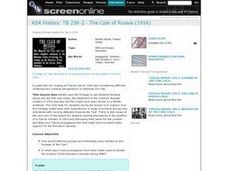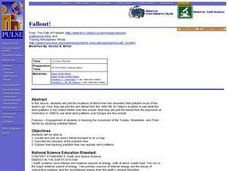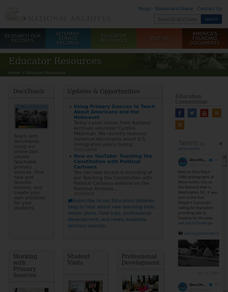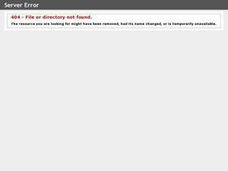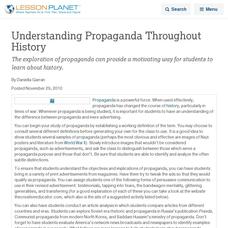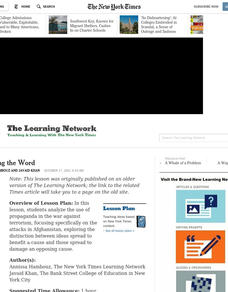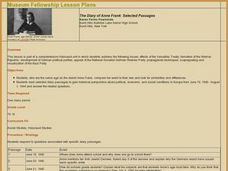Curated OER
WWI and Russian Revolution
Students view and discuss footage of Tsar Nicholas II reviewing troops on the Eastern Front in 1916 and examine how different groups would have reacted to this footage of the Tsar. They watch the video and in small groups answer...
Curated OER
WW II Magazine
Eleventh graders search the database for pictures of WW II, photographs, posters, etc. They use the documents to support writing two magazine articles. The magazine articles be a minimum of 500 and maximum 1000 words.
Curated OER
Perception Propaganda
Eleventh graders explore the various uses of perception, propaganda, and perspective. In this Social Studies lesson, 11th graders distinguish between fact and fiction. Students analyze the impact of conflict on society.
Curated OER
Art and Patriotic Culture
Art forms, especially government-sponsored "poster art", very effectively conveyed specific cultural values during World War II. Understanding the role that visual images play in expressing issues and ideas is critical to developing...
Curated OER
Fallout
High schoolers view a short film about the results of dropping the atomic bomb at the end of World War II. They research controversies surrounding the use of the bomb and nuclear weapons. They write two editorials about the issue.
Curated OER
Memorandum Regarding the
Students use the National Archives to research the memorandum regarding the enlistment of Navajo Indians during World War II.
Curated OER
Art Imitates Life
Elementary and middle schoolers examine postcards depicting World War I events. Eventually, they create prints that reflect their own lives. In an interesting blend of history and current events, this instructional activity should engage...
NPR
Progressive Era Lesson Plan
The women working for equal rights in the early 20th century weren't a part of one large group; rather, they were members of dozens of small groups focused on social reform. Explore the ways groups in the Progressive Era like National...
Historica-Dominion Institute
Artifact Creation Activity
Creating an artifact that is representative of a specific time period provides an opportunity for amateur historians to understand the importance of primary sources. This resource describes the process for students to explore original or...
Curated OER
The Homefront: America and WWII
Students are introduced to the experiences of various groups of Americans at home during WWII, highlighting race, gender, and ethnicity. They improve their ability to analyze and interpret historical documents and images.
Curated OER
The Diary of Anne Frank: Research Project on Concentration Camps during World War II
Eighth graders investigate the Holocaust and the persecution of specific ethnic groups in Europe during World War II.
Curated OER
Understanding Propaganda Throughout History
The exploration of propaganda can provide a motivating way for students to learn about history.
Curated OER
Adolf Hitler: Was Hitler a Passionate Lunatic?
Young scholars investigate WWII by researching Adolf Hitler. In this dictator biographical lesson, students identify the role Adolf Hitler played in the self destruction of Germany by reading secret transcripts from German leaders. Young...
Curated OER
What Was the Cold War?
A study of the Cold War can helps students learn about history through interviewing people who lived through this period.
Curated OER
Spreading the Word
Students analyze the use of propaganda in the war against terrorism, focusing specifically on the attacks in Afghanistan, exploring the distinction between ideas spread to benefit a cause and those spread to damage an opposing cause.
Curated OER
Teaching With Documents: Powers of Persuasion - Poster Art of World War II
Students analyze 11 posters from wartime and complete a worksheet. They discuss the similarities and differences between the posters and where the posters might have been posted. Student volunteers from each group present the posters to...
Curated OER
The Diary of Anne Frank: Selected Passages
Students read the novel, "The Diary of Anne Frank". Using the internet, they gather information on the effect of the Versailles Treaty, formation of the Weimer Republic and the Nazi Party on the Holocaust. They view propaganda...
Curated OER
Remembering the First
Young scholars examine words and phrases associated with World War I as an introduction the era. They explore the legacy of World War I by reading and discussing "The War to End All Wars If Only." Students write obituries for fallen...
Film Education
Nineteen Eighty-Four: Orwell
Warning or prediction? Nineteen Eighty Four is the anchor text for a series of tasks that ask readers to compare the novel to the film as well as current events to those pictured in George Orwell's dystopian classic.
Curated OER
GI's, Gals & Gardens
Students, in groups, design a war participation campaign for a specific audience during WWII. They design posters and prepare an oral presentation for the class.
Curated OER
Kansas in the Movies, the Cold War Period
Young scholars are instructed using a cross curricular type of instructional activity. The time period that they focus upon is the founding of the Soviet Union as a superpower in the world after WWII. The rise of communism is also taken...
Roy Rosenzweig Center for History and New Media
Analyzing Political Campaign Commercials
Imagine a lesson that models for learners how to separate facts from opinions. How to detect bias. How to evaluate a source of information. How to identify propaganda. Although designed for middle schoolers, the activities in this packet...
Curated OER
Antisemitism
Eighth graders explore antisemitism and propaganda and stereotypes. They make connections to current-day antisemitism, racism, prejudice and bigotry.
Curated OER
The Arms Race - From the Beginning to the End
Ninth graders focus on the political and technological developments of the Cold War. They, in groups, read and summarize the speech they are given. They should provide a short presentation based on their interpretation.


